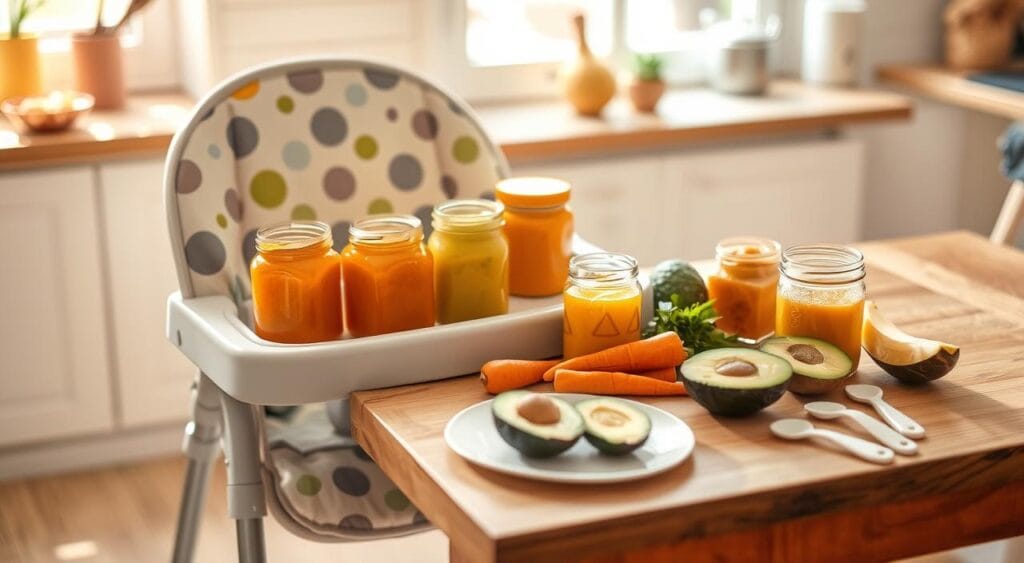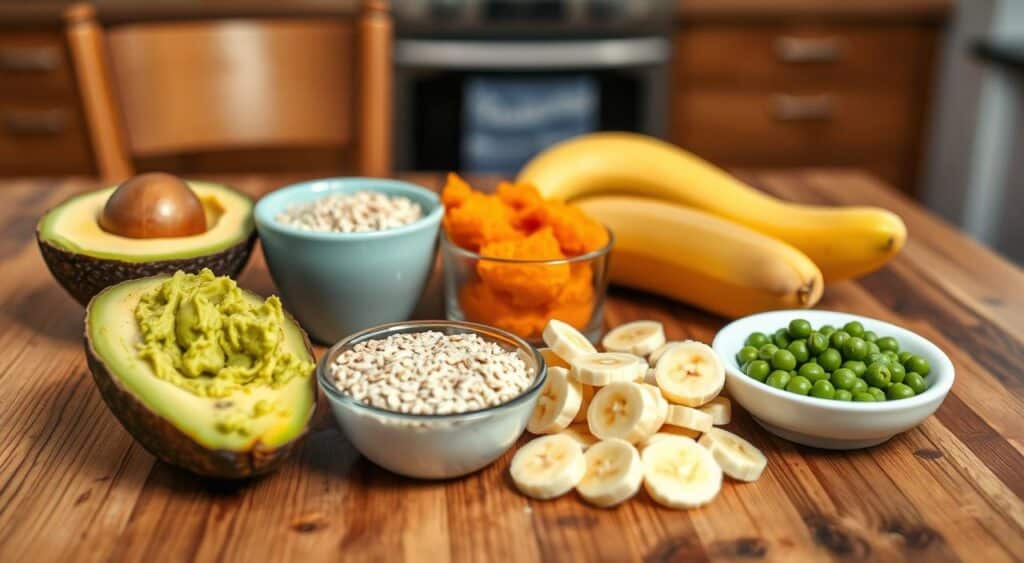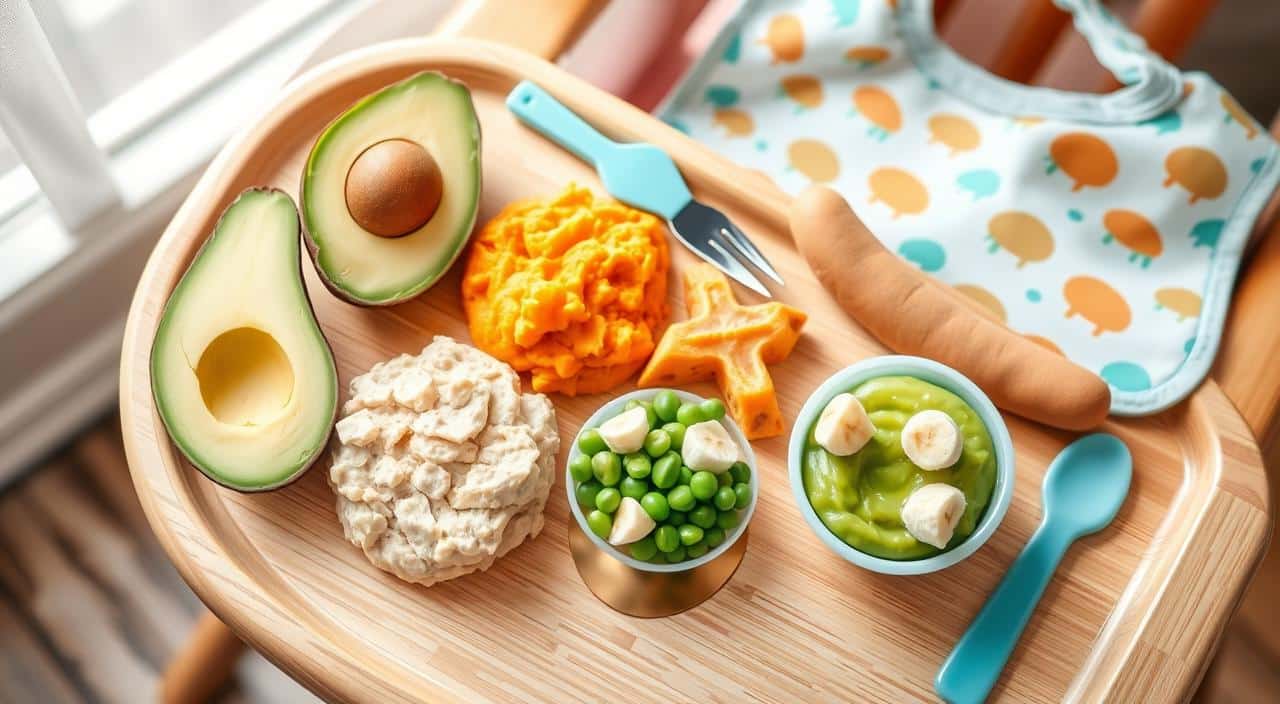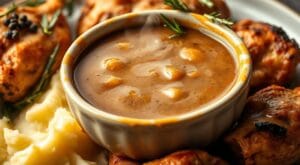Jump to:
Estimated reading time: 11 minutes
Table of contents
What are good baby foods to start with? When your baby is 4 to 6 months old, it’s time to introduce solids. This lets them discover new tastes and textures. But remember, solids don’t replace breast milk or formula yet. They should be given after your baby has eaten enough from milk.
The American Academy of Pediatrics (AAP) suggests starting solids at 6 months. But, every baby is different. Some might be ready sooner, while others might wait longer. Never start solids before 4 months.
To know if your baby is ready, look for signs. Can they sit up and hold their head? Are they curious about food? Do they seem hungry after drinking milk all day?
What are good baby foods to start with? Key Takeaways
- Babies can start solid foods between 4-6 months of age, but the AAP recommends around 6 months.
- Look for signs of readiness, such as sitting up, head control, and interest in food.
- Solids should not replace breast milk or formula as the primary nutrition source.
- Introduce new foods one at a time and watch for any allergic reactions.
- Homemade baby foods provide superior nutrition and cost-effectiveness compared to store-bought options.
What are good baby foods to start with? Introduction
Starting your baby on solid foods is a big step in their growth. You want to give them the best nutrition for their health. This guide will help you pick the right first foods and introduce them safely.
The American Academy of Pediatrics suggests starting with breast milk for the first six months. Then, introduce solid foods gradually. Around 4 months, when your baby has doubled their birth weight, they might be ready. But, the best time is usually between 4 and 6 months.
Choosing the right first foods is key. It’s also important to know how to introduce them safely. This helps your baby grow well, reduces allergy risks, and builds a good food relationship.

We’ll talk about the best fruits and veggies, iron-rich foods, and whole grains. We’ll also cover how to introduce new foods safely. You’ll learn how to make homemade baby food and know when your baby is ready for solids. By the end, you’ll be ready to start your baby’s solid food journey.
Why It’s Important to Choose the Right First Foods for Your Baby
Choosing the right first foods for your baby is key for their growth and health. It helps avoid food allergies and builds a good food relationship. The foods you introduce in the first year shape their eating habits and health for life.
Supporting Healthy Growth and Development
Starting with nutrient-rich, age-right foods gives your baby the vitamins and calories they need. Early exposure to many flavors makes them more open to trying new foods. It also helps their taste buds grow.
Reducing the Risk of Allergies
Introducing foods like eggs, peanuts, and fish at 6 months can lower allergy risk. This early introduction helps their immune system get used to these foods. It leads to a better immune response.
Encouraging a Positive Eating Experience
Offering a variety of nutritious foods in a calm setting helps your baby enjoy meals. This creates a positive mealtime experience. It’s the start of a healthy food relationship for life.

“Introducing the right first foods can have a lasting impact on your baby’s health and development.”
Choosing the right first foods is a big step for your baby’s health and eating habits for life.
What are good baby foods to start with? Best Fruits and Vegetables to Start With
Experts say to start with mild, easy-to-digest baby foods. This includes baby fruit and vegetable purees. These foods help your baby get used to solid foods and try new tastes.
Mild Fruits: Bananas, Apples, and Pears
Soft bananas, crisp apples, and juicy pears are great for first bites. They are sweet, easy to digest, and full of vitamins and minerals. These help your baby grow and develop.
Gentle Vegetables: Sweet Potatoes, Carrots, and Avocados
Start with soft vegetables like sweet potatoes, carrots, and avocados. They are smooth, flavorful, and good for your baby. Sweet potatoes and carrots have vitamin A, and avocados have healthy fats.
Combining Fruits and Vegetables for Added Nutrition
Try mixing baby fruit and vegetable purees for more nutrition. For example, sweet potatoes and apples or carrots and pears make tasty, balanced meals.
“Registered Dietitian Nicole Lattanzio advises starting solids close to 6 months based on readiness signs like good head and neck control, ability to sit unassisted, and integration of tongue thrust reflex.”
What are good baby foods to start with? Introducing Iron-Rich Foods for Babies
When your baby is about 6 months old, it’s time to add iron-rich foods to their diet. The iron they got from you while they were growing inside you starts to run out. Adding foods like iron-fortified cereals, pureed meats, and legumes is key for their growth.
Iron-Fortified Cereals: Oatmeal and Rice Cereal
Iron-fortified cereals, like oatmeal and rice, are great for babies. One tablespoon of iron-fortified oatmeal cereal has 2 milligrams of iron. This is 18% of what babies need every day.
Pureed Meats: Chicken, Beef, and Turkey
Pureed meats, like chicken, beef, and turkey, are full of haem iron. This iron is easy for the body to use. For example, one ounce of ground beef has 0.7 milligrams of iron. This meets 6% of a baby’s daily iron needs.
Legumes: Lentils and Peas
Legumes, like lentils and peas, are good for babies. A quarter cup of white beans has 2 milligrams of iron. This is 18% of what a baby needs. Peas are also a tasty, iron-rich choice.
Mixing different iron-rich foods into your baby’s meals is important. It helps them get the nutrients they need to grow strong and healthy.
What are good baby foods to start with? Starting with Whole Grains and Dairy
You can start adding whole grains and dairy to your baby’s diet. Good choices include cooked quinoa and barley, unsweetened yogurt, and cottage cheese. Also, soft-cooked pasta is great. These foods give your baby complex carbs, protein, and important vitamins and minerals.
Cooked Quinoa and Barley
Quinoa and barley are full of fiber and vitamins. Cook them until they’re soft. Start with a little and add more as your baby gets used to them.
Unsweetened Yogurt and Cottage Cheese
Unsweetened yogurt and cottage cheese are rich in protein and calcium. Choose plain, unsweetened types. Mix in some pureed fruit for sweetness and extra nutrients.
Small Pieces of Soft-Cooked Pasta
Soft pasta is a good way to introduce grains to your baby. Use shapes like macaroni or penne. Cook them until they’re very soft for easy chewing and swallowing.
Introduce new foods one at a time and wait 3-5 days before adding another. This helps watch for any allergic reactions. With these healthy options, you can help your baby start a balanced diet for lifelong health.
What are good baby foods to start with? How to Introduce New Foods Safely
Introducing new foods to your baby needs patience and caution. Experts say to wait three to five between each new food. This lets your baby’s body adjust and watch for any allergic reactions.
Observing for Signs of Allergic Reactions
Watch for signs like a rash, hives, or stomach problems. If you see any, call your pediatrician fast. Slowly introducing foods and watching your baby helps keep them safe and healthy.
Offering New Foods in a Positive and Stress-Free Environment
Make the feeding time positive and stress-free. Give new foods when your baby is calm. Avoid distractions to make mealtime fun and enjoyable.
“Creating a positive feeding environment is key for your baby’s growth and trying new foods.”
Introducing foods safely and patiently helps your baby develop good eating habits for life.
| Key Considerations for Introducing New Foods | Best Practices |
|---|---|
| Waiting between new foods | Wait 3-5 days before introducing a new food |
| Observing for allergic reactions | Monitor for rash, hives, or gastrointestinal distress |
| Creating a positive feeding environment | Offer new foods when baby is calm and relaxed |
What are good baby foods to start with? Tips for Making Homemade Baby Food
Making your own baby food at home is rewarding and saves money. Choose fresh, organic ingredients for the best nutrients. Properly storing homemade purees keeps them safe and fresh.
Choosing Fresh, Organic Ingredients
Choosing organic produce avoids harmful chemicals. Seasonal fruits and veggies are affordable and full of vitamins. They support your baby’s growth.
Preparing and Storing Homemade Purees
Use a food processor or blender for purees. Cook foods well before blending for easy digestion. Store purees in airtight containers or ice cube trays to keep them fresh.
Adjusting Textures as Your Baby Grows
Change food textures as your baby gets older. Start with smooth purees and move to chunkier foods. This helps with chewing and swallowing.
Making homemade baby food is rewarding. It lets you control the ingredients and flavors. By choosing organic and adjusting textures, you ensure your baby gets the best nutrition.
How to Recognize When Your Baby Is Ready for Solid Foods
Introducing solid foods is a big step in your baby’s growth. The American Academy of Pediatrics suggests starting around 6 months. But, every baby is different, and some might be ready sooner or later.
Signs of Readiness: Sitting Up and Showing Interest in Food
One important sign is when your baby can sit up without much help. They should also have good head control and not push food out with their tongue. If they’re interested in your food and try to grab it, they’re likely ready to start eating solids.
The Importance of Maintaining Breastfeeding or Formula Feeding Alongside Solids
It’s exciting to start solid foods, but don’t stop breastfeeding or formula feeding. Breastfeeding and solids or formula and solids should work together. This ensures your baby gets all the nutrients they need to grow.
Managing Feeding Schedules and Establishing a Routine
Having a regular feeding schedule and routine helps your baby adjust to solids. Start with small amounts, watch for signs they’re full, and find a routine that fits your family. This makes the transition smoother for everyone.
“Introducing solid foods is an exciting milestone, but it’s important to pay attention to the signs of readiness and maintain a balanced approach with breastfeeding or formula feeding.”
What are good baby foods to start with? Frequently Asked Questions.
What are the best first foods for babies?
Good first foods for babies include single-ingredient purees like sweet potatoes, carrots, apples, and bananas. These foods are gentle on the stomach and easy to digest, making them ideal for babies starting solids.
When can I introduce solid foods to my baby?
Babies can generally start solid foods around 6 months old when they show readiness signs like sitting up with minimal support and showing interest in food. Always consult with your pediatrician before starting solids
Are cereals a good first food for babies?
Yes, iron-fortified cereals like rice or oatmeal are popular first foods because they are gentle on the digestive system and provide essential iron. You can mix them with breast milk or formula for added nutrition.
Should I introduce fruits or vegetables first?
Either is fine, though some parents prefer starting with vegetables to avoid developing a preference for sweetness early on. Whichever you choose, introduce new foods gradually to monitor for any potential allergies.
How should I prepare baby’s first foods?
Start with simple purees by steaming and mashing fruits or vegetables, or thin them with breast milk or formula. Begin with smooth textures, then gradually introduce thicker consistencies as your baby becomes comfortable.
Conclusion
Starting solid foods is a big step for your baby. It’s important to pick the right foods, like iron-rich cereals and pureed meats. Also, include a variety of fruits and veggies. This helps your baby grow strong and healthy.
Always watch out for safety, like trying new foods one at a time. Make mealtime fun to help your baby love eating. This will help them eat well for life.
Feeding your baby is a journey. Be patient and listen to what they need. Try new things and get advice from your pediatrician. This way, your baby will learn to love healthy food.
Choosing the best foods for your baby is key. Make sure to introduce them safely and keep mealtime positive. This will help your child stay healthy and love eating nutritious food for years to come.






